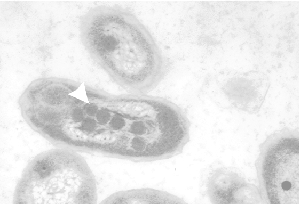| |
 Image credit: M. Bright and K. Scott
Image credit: M. Bright and K. Scott |
Chemoautotrophy
Chemoautotrophs
grow by powering CO2 fixation with
the energy released by the oxidation of a smorgasbord of redox substrates.
Electron donors utilized by these organisms include reduced sulfur
(H2S, S2O3-2,
S°, etc.), reduced iron (e.g., Fe+2,
pyrite), reduced nitrogen (NH3, NO2-)
and H2 (Kuenen and Bos, 1989), while
O2, NO3-,
SO4-2,
and Fe+3 can serve as electron acceptors
(Kelly and Wood, 2001). By coupling the oxidation and reduction of
inorganic compounds to the generation of biomass, the activities of
these organisms tie the geochemical cycle of their redox substrates
to the carbon, nitrogen, and phosphorus cycles. Further, at H2S,
Fe+2, and H2-rich
deep-sea hydrothermal vents and cold seeps, free-living and symbiotic
sulfur-oxidizing chemoautotrophs are dominant primary producers (Jannasch,
1979).
Sulfur oxidation
The bacteria
of the oxidative part of the sulfur cycle are of global importance
and catalyze complex pathways for the complete oxidation of sulfide
to sulfate. One of the important groups catalyzing the oxidation
of reduced sulfur compounds in the marine environment are bacteria
belonging to the genus Thiomicrospira, a group which
originally included all marine, spiral-shaped sulfur oxidizing
bacteria. Subsequent analyses of 16S rDNA sequences have revealed
the polyphyletic nature of this group; members of Thiomicrospira are
distributed among the gamma and epsilon subdivisions of the Proteobacteria.
All Thiomicrospira species characterized to date are
obligate chemolithoautotrophic bacteria that use sulfide, thiosulfate,
and elemental sulfur as electron donors, and CO2 as
their carbon source. Two organisms (gamma and epsilon-Proteobacteria)
have been selected to embrace the phylogenetic breadth of proteobacterial
chemoautotrophs
Thiomicrospira crunogena
The gamma-Proteobacterium T. crunogena is
cosmopolitan. Originally isolated from the East Pacific Rise (Jannasch
et al., 1985), it was subsequently cultivated or detected with molecular
methods from deep-sea vents in both the Pacific and Atlantic (Wirsen
et al., 1998). Further, closely related species have been found at shallow-water
hydrothermal vents (Muyzer et al., 1995; Brinkhoff et al., 1999). It
has a remarkably high growth rate for a chemoautotroph (Jannasch et al.,
1985).
References
Brinkhoff,
T., Sievert, S.M., Kuever, J., and Muyzer, G. (1999) Distribution
and diversity of sulfur-oxidizing Thiomicrospira spp.
at a shallow-water hydrothermal vent in the Aegean Sea (Milos,
Greece). Appl. Environ. Microbiol. 65: 3843-3849.
Huber, J., Butterfield, D.A., and Baross, J.A. (2003) Bacterial diversity
in a subseafloor habitat following a deep-sea volcanic eruption. FEMS Microbiol.
Ecol. 43: 393-409.
Jannasch HW, Wirsen
CO (1979) Chemosynthetic primary production at East Pacific sea floor
spreading centers. BioSci. 29: 592-598.
Jannasch, H., Wirsen, C., Nelson, D., and Robertson, L. (1985) Thiomicrospira
crunogena sp. nov., a colorless, sulfur-oxidizing bacterium from
a deep-sea hydrothermal vent. Int. J. Syst. Bacteriol. 35: 422-424.
Kelly, D.P., and Wood, A.P. (2001). The chemolithotrophic prokaryotes.
URL http://80-link.springer-ny.com.ezp2.harvard.edu/link/service/books/10125/.
Kuenen, J.G., and Bos, P. (1989) Habitats and ecological niches of chemolitho(auto)trophic
bacteria. In Autotrophic Bacteria. Schlegel, H.G., and Bowien, B. (eds).
Madison: Springer-Verlag, pp. 117-146.
Muyzer, G., Teske, A., Wirsen, C., and Jannasch, H. (1995) Phylogenetic
relationships of Thiomicrospira species and their identification
in deep-sea hydrothermal vent samples by denaturing gradient gel electrophoresis
of 16S rDNA fragments. Archives of Microbiology 164: 165-172.
Reysenbach, A.-L., Longnecker, K., and Kirshtein, J. (2000) Novel bacterial
and archaeal lineages from an in situ growth chamber deployed at a Mid-Atlantic
Ridge hydrothermal vent. Appl. Environ. Microbiol. 66: 3798-3806.
Timmer-Ten Hoor, A. (1975) A new type of thiosulphate oxidizing, nitrate
reducing microorganism: Thiomicrospira denitrificans sp. nov.
Netherland Journal of Sea Research 9: 344-350.
Watanabe, K., Watanabe, K., Kodama, Y., Syutsubo, K., and Harayama,
S. (2000) Molecular characterization of bacterial populations
in petroleum-contaminated groundwater discharged from underground
crude oil storage cavities. Appl Environ Microbiol 66: 4803-4809.
Wirsen, C.O., Brinkhoff, T., Kuever, J., Muyzer, G., Jannasch, H.W.,
and Molyneaux, S.J. (1998) Comparison of a new Thiomicrospira strain
from the mid-atlantic ridge with known hydrothermal vent isolates.
Applied and Environmental Microbiology 64: 4057-4059.
|